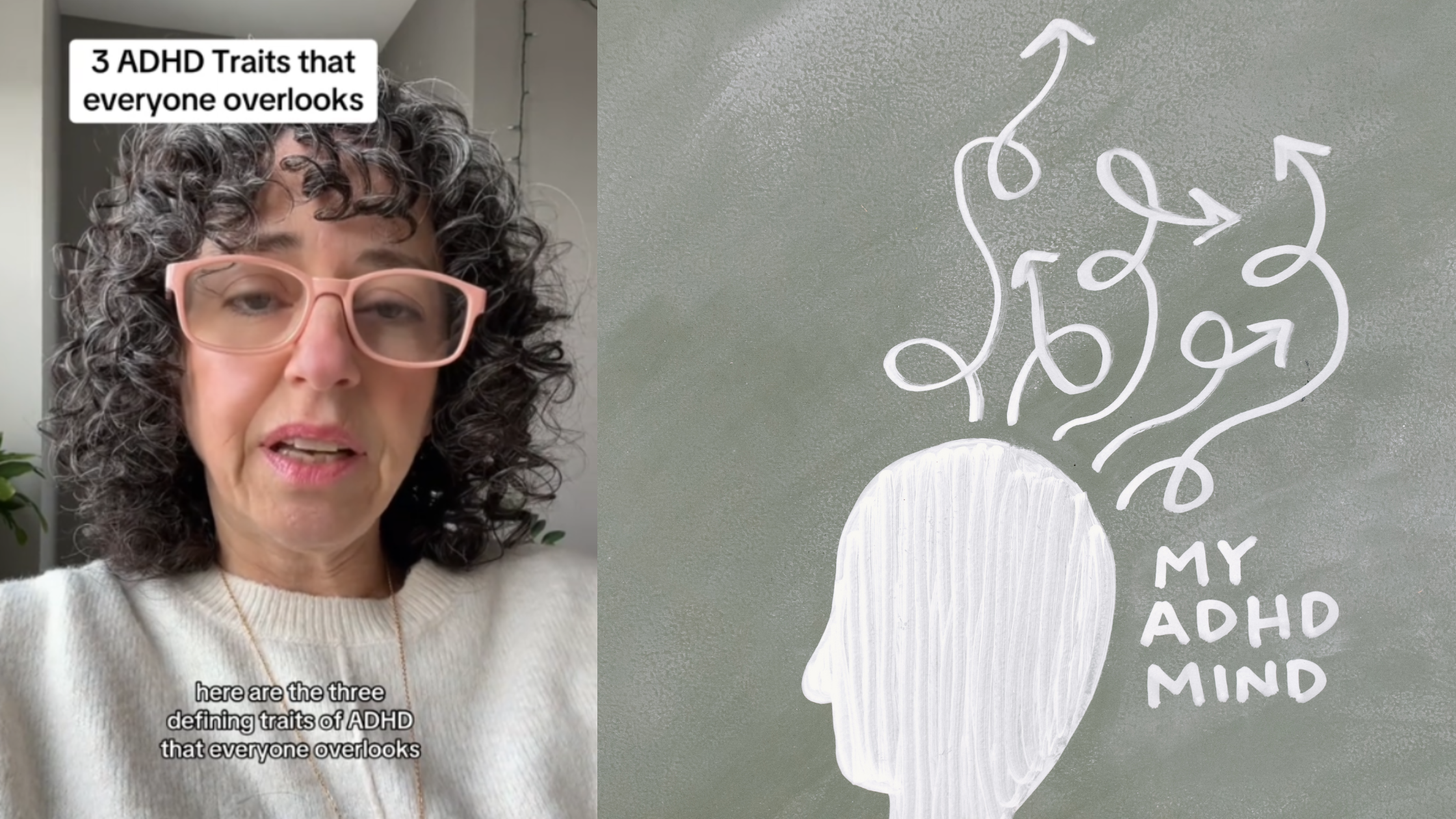Woman Diagnosed With ADHD Later In Life Explains The Three ‘Defining Traits’ People May Miss

As we navigate adulthood, we often uncover hidden aspects of ourselves—parts that were misunderstood or overlooked in our earlier years. For many, this journey includes the surprising realization of living with Attention Deficit Hyperactivity Disorder (ADHD), a condition traditionally associated with childhood.
One woman, diagnosed later in life, shared her experience of uncovering traits she never connected to ADHD—traits that are subtle, profound, and often missed in discussions about the condition. Her story sheds light on the complexity of ADHD in adults, especially in ways that challenge the stereotypes of distraction and hyperactivity.
Understanding ADHD in Adults
@rebelwithoutadrink As a late diagnosed ADHD adult, I had no idea these were considered ADHD symptoms. Looking back on my life makes so much more sense knowing this! #adhd #adhdinwomen #adhdtiktok
♬ original sound – Coach Jennifer
For years, ADHD (Attention Deficit Hyperactivity Disorder) has been viewed primarily as a childhood disorder, but this perspective is changing. Recent data reveals a growing recognition of ADHD in adults, challenging the outdated belief that the condition fades with age. A study published in JAMA found that the prevalence of adult ADHD diagnoses doubled between 2007 and 2016, underscoring a shift in awareness and understanding.
This evolution reflects a deeper appreciation of how ADHD manifests differently in adults compared to children. While hyperactivity is often a hallmark symptom in childhood, adult ADHD tends to present more subtly. Challenges like disorganization, poor time management, and difficulty completing tasks are common but less overt, making the condition harder to identify.
The complexity of diagnosing ADHD in adults is further compounded by its overlap with other mental health conditions. Symptoms may be misattributed or masked entirely, leading to misdiagnosis or a failure to recognize ADHD as the root cause. As ADHD Coach Jennifer Salzman explains, “Most cases of ADHD are diagnosed during childhood, but signs displayed in childhood are often overlooked or misdiagnosed.” This underscores the need for a more nuanced approach to understanding and identifying ADHD in adults, particularly those whose symptoms went unnoticed in earlier years.
First Trait: The Interest-Based Nervous System
 Image source: Pexels
Image source: Pexels
One of the most insightful revelations about ADHD in adults is the concept of an interest-based nervous system. This perspective reframes the traditional view of ADHD as merely a deficit of attention. Instead, it highlights a pattern of inconsistent attention that is not driven by necessity or obligation but by genuine interest.
Dr. William Dodson, an ADHD specialist, explains this unique characteristic: “ADHD doesn’t actually cause a deficit of attention; it causes inconsistent attention that is only activated by certain circumstances.” These circumstances often include triggers like interest, passion, novelty, challenge, or urgency. This means that individuals with ADHD are not incapable of focus but are instead highly selective about what engages their attention.
This phenomenon can lead to prioritizing interesting tasks over important ones, sometimes at the expense of pressing responsibilities. ADHD Coach Jennifer Salzman, also known as @rebelwithoutadrink, elaborates: “The interest-based system means that those with ADHD tend to prioritize interesting topics over important ones, even if they come with a consequence or add pressure to completing another task.”
Second Trait: Emotional Hyper-Arousal
 Image source: Pexels
Image source: Pexels
Another defining yet often overlooked trait of ADHD in adults is emotional hyper-arousal. This condition is marked by an intense, rapid, and overwhelming emotional response to everyday situations, setting it apart from the more measured emotional reactions most people experience.
Jennifer Salzman reflects on her personal journey with this trait, describing it as living with “an intense, rapid, and overwhelming response to things.” For years, she grappled with these heightened emotions, unaware of their connection to ADHD. Dr. William Dodson sheds light on this phenomenon, stating, “People with ADHD have passionate thoughts and emotions that are more intense than those of the average person. Their highs are higher and their lows are lower.”
This heightened emotional experience means that individuals with ADHD feel both positive emotions and criticism more acutely than their peers, adding a layer of emotional complexity to their daily lives. While this emotional depth can bring vibrant joy and enthusiasm, it also amplifies negative feelings, creating challenges in managing stress or setbacks.
The implications of emotional hyper-arousal extend beyond personal well-being, often affecting social interactions and relationships. Those with ADHD may find themselves in a constant battle with their emotions, which can appear disproportionate to the situations that trigger them. This can lead to misunderstandings and strained relationships, as others may perceive their reactions as exaggerated or unwarranted.
Third Trait: Rejection Sensitivity
 Image source: Pexels
Image source: Pexels
Rejection sensitivity is a deeply impactful trait of ADHD, characterized by an intense emotional response to rejection, criticism, or even the perception of these. Jennifer Salzman describes it as “that feeling of intense emotional pain whenever we feel like we’re being criticized or rejected,” a sentiment shared by many with ADHD.
Dr. William Dodson explains this condition, clinically known as rejection sensitive dysphoria (RSD), as a heightened fear of rejection that can lead to two distinct reactions: an immediate, intense anger directed outward or an inward spiral into emotional distress, sometimes severe enough to mimic mood disorders. These reactions often result in misdiagnosis, masking the underlying ADHD and complicating treatment.
The effects of rejection sensitivity can ripple through personal and professional life, causing individuals to avoid situations where they fear rejection or criticism. This avoidance can stifle opportunities for growth and connection, reinforcing feelings of inadequacy. Understanding this trait is crucial for fostering empathy and developing strategies to help those with ADHD build confidence and resilience in the face of perceived rejection.
Coping Mechanisms and Management Strategies
Managing ADHD in adulthood requires a comprehensive approach that includes the following strategies:
- Medication: Stimulant medications can help improve focus and reduce distractions, but they must be paired with additional strategies to spark initial engagement.
- Behavioral Strategies: Techniques like body-doubling (working alongside someone else) or injecting interest into mundane tasks can significantly enhance task engagement.
- Support Systems: Having a supportive network of family, friends, or professionals provides the encouragement and validation needed to navigate emotional and practical challenges.
- Workplace and Educational Accommodations: Adjustments such as flexible schedules, structured breaks, and varied tasks can help individuals manage their symptoms effectively in professional and academic settings.
- Community Engagement: Participating in ADHD-focused support groups, forums, or workshops creates a sense of belonging and offers practical strategies from others with shared experiences.
By combining these approaches, individuals with ADHD can build a robust toolkit for managing their symptoms and thriving in daily life.
Embracing the Full Spectrum of ADHD in Adulthood
ADHD in adulthood is a multifaceted condition that extends far beyond common stereotypes of hyperactivity or distraction. Traits like the interest-based nervous system, emotional hyper-arousal, and rejection sensitivity shape the way individuals experience and respond to the world, often in ways that are misunderstood or overlooked. Recognizing these traits not only helps those with ADHD better understand themselves but also fosters greater empathy and support from others.
With the right combination of strategies—medication, behavioral tools, support systems, and accommodations—adults with ADHD can navigate their challenges while embracing their unique strengths. By creating an environment of understanding and offering tailored solutions, we can empower individuals with ADHD to thrive, not despite their condition, but because of the resilience, creativity, and perspective it often brings.
Featured Image from Coach Jennifer on TikTok
Sources:
- Young, S., Adamo, N., Ásgeirsdóttir, B. B., Branney, P., Beckett, M., Colley, W., Cubbin, S., Deeley, Q., Farrag, E., Gudjonsson, G., Hill, P., Hollingdale, J., Kilic, O., Lloyd, T., Mason, P., Paliokosta, E., Perecherla, S., Sedgwick, J., Skirrow, C., . . . Woodhouse, E. (2020). Females with ADHD: An expert consensus statement taking a lifespan approach providing guidance for the identification and treatment of attention-deficit/ hyperactivity disorder in girls and women. BMC Psychiatry, 20(1). https://doi.org/10.1186/s12888-020-02707-9
-
Quinn, P. O. (2005). Treating adolescent girls and women with ADHD: Gender‐Specific issues. Journal of Clinical Psychology, 61(5), 579–587. https://doi.org/10.1002/jclp.20121
-
Lundervold, A. J., Hinshaw, S. P., Sørensen, L., & Posserud, M. (2016). Co-occurring symptoms of attention deficit hyperactivity disorder (ADHD) in a population-based sample of adolescents screened for depression. BMC Psychiatry, 16(1). https://doi.org/10.1186/s12888-016-0739-3
Loading...






